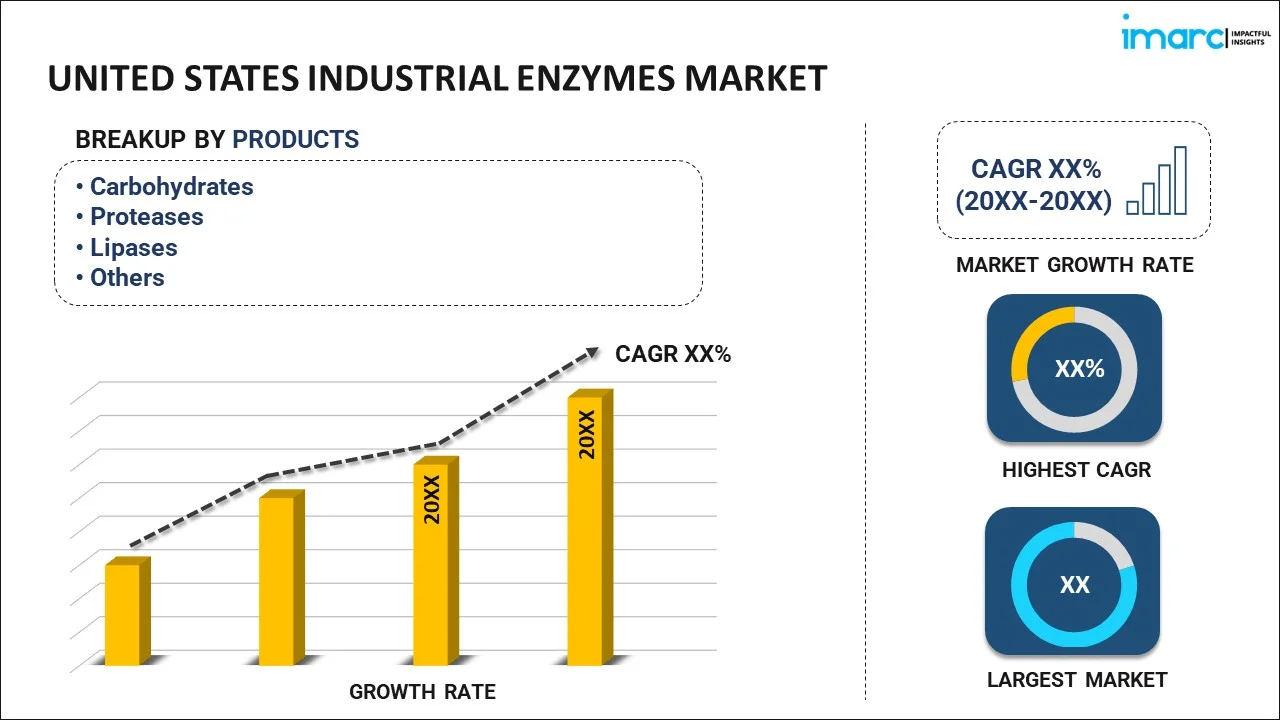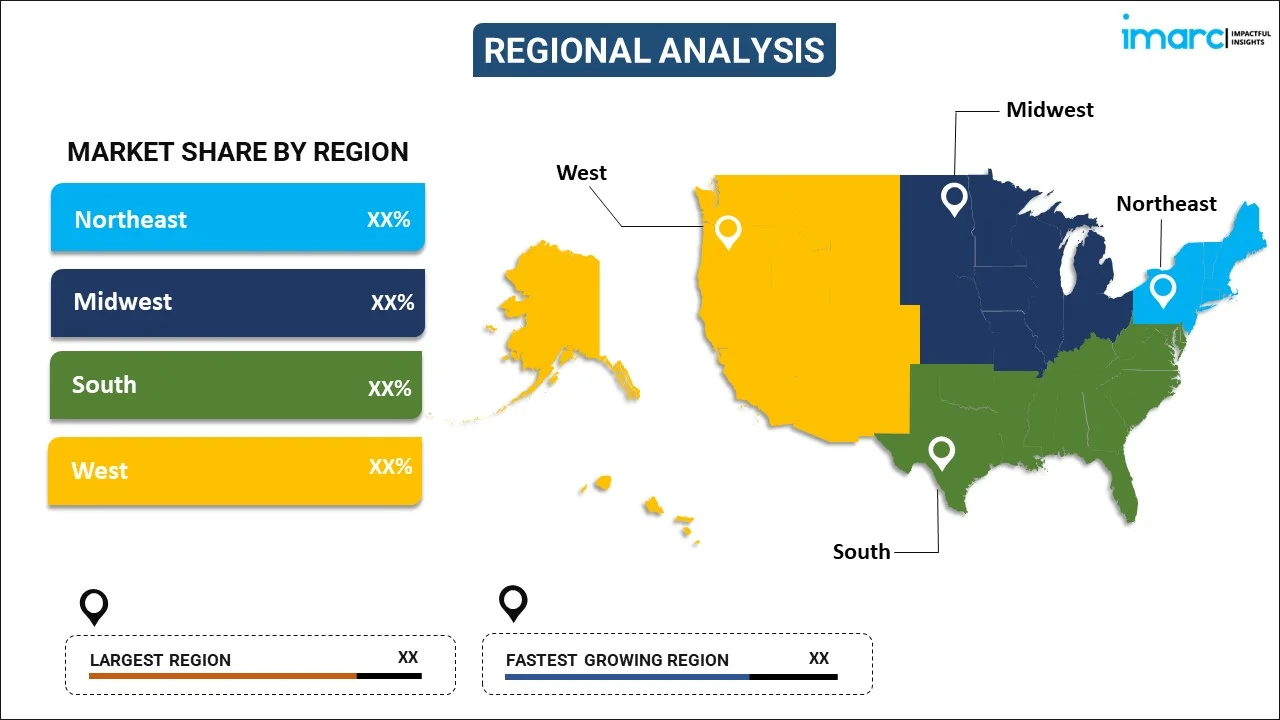
United States Industrial Enzymes Market Report by Product (Carbohydrates, Proteases, Lipases, Polymerases and Nucleases, and Others), Source (Plants, Animals, Microorganisms), Application (Food and Beverages, Detergents, Animal Feed, Biofuels, Textiles, Pulp and Paper, Nutraceuticals, Personal Care and Cosmetics, Wastewater Treatment, and Others), and Region 2025-2033
Market Overview:
United States industrial enzymes market size reached USD 1.8 Billion in 2024. Looking forward, IMARC Group expects the market to reach USD 2.4 Billion by 2033, exhibiting a growth rate (CAGR) of 3.4% during 2025-2033. The growing demand for biofuels, driven by environmental concerns, rising collaboration between key market players to discover and develop new formulations and increasing development in production techniques, such as protein engineering and metagenomics, represent some of the key factors driving the market.
|
Report Attribute
|
Key Statistics
|
|---|---|
|
Base Year
|
2024 |
|
Forecast Years
|
2025-2033
|
|
Historical Years
|
2019-2024
|
| Market Size in 2024 | USD 1.8 Billion |
| Market Forecast in 2033 | USD 2.4 Billion |
| Market Growth Rate (2025-2033) | 3.4% |
Industrial enzymes are specialized proteins that act as catalysts to accelerate chemical reactions in industrial applications. These enzymes are derived from living organisms, such as bacteria, fungi, and plants, and employed to enhance the efficiency of various processes. They are available in amylases, proteases, lipases, cellulases, and ligninases, each categorized based on their applications. They enable the use of milder conditions, reducing energy consumption. They contribute to sustainable practices by reducing the need for harsh chemicals. They can reduce production costs by increasing process efficiency and reducing waste. They often replace harsh chemicals and are generally safer to handle than many chemical alternatives. They enhance product quality and consistency and can be customized for specific applications, making them versatile tools. They are utilized in a wide array of sectors, including food and beverage (F&B), textile, pulp and paper, biofuels, and waste management.
United States Industrial Enzymes Market Trends:
At present, the increasing demand for biofuels, driven by environmental concerns and the shift towards sustainable energy sources, represents one of the key factors impelling the market growth in the United States. These enzymes are utilized in the biofuel industry, particularly in the production of cellulosic ethanol, to break down complex carbohydrates into fermentable sugars. Additionally, the growing focus on enzymes as a greener alternative to chemical catalysts, as they operate under milder conditions, reduce energy consumption, and generate fewer byproducts, is offering a favorable market outlook. Besides this, the rising employment of enzymes, such as amylases, proteases, and lipases in the F&B industry for improving food texture and flavor is bolstering the market growth in the country. They also enhance the nutritional value and help in developing gluten-free and low-lactose products, catering to specific dietary needs and preferences. Moreover, there is an increase in the use of enzymes in pharmaceutical and nutraceutical applications, driven by the need for more effective and targeted therapeutics. These enzymes are being explored for drug manufacturing, especially in the production of chiral compounds and as active ingredients in various medications. The nutraceutical sector also sees enzymes playing a role in enhancing the nutritional value and absorption of health supplements. In addition, the growing development in production techniques, such as protein engineering and metagenomics, are enabling the creation of enzymes that are more efficient, stable, and specific to industrial applications. This progress not only enhances the performance of enzymes in traditional sectors but also facilitates their expansion into novel areas. Furthermore, the rising collaboration between key market players to discover and develop new enzymes with improved functionalities and optimize production processes for higher efficiency and lower costs is supporting the market growth in the country.
United States Industrial Enzymes Market Segmentation:
IMARC Group provides an analysis of the key trends in each segment of the market, along with forecasts at the country level for 2025-2033. Our report has categorized the market based on product, source, and application.
Product Insights:

- Carbohydrates
- Amylases
- Cellulase
- Others
- Proteases
- Lipases
- Polymerases and Nucleases
- Others
The report has provided a detailed breakup and analysis of the market based on the product. This includes carbohydrates (amylases, cellulase, and others), proteases, lipases, polymerases and nucleases, and others.
Source Insights:
- Plants
- Animals
- Microorganisms
A detailed breakup and analysis of the market based on the source have also been provided in the report. This includes plants, animals, and microorganisms.
Application Insights:
- Food and Beverages
- Detergents
- Animal Feed
- Biofuels
- Textiles
- Pulp and Paper
- Nutraceuticals
- Personal Care and Cosmetics
- Wastewater Treatment
- Others
The report has provided a detailed breakup and analysis of the market based on the application. This includes food and beverages, detergents, animal feed, biofuels, textiles, pulp and paper, nutraceuticals, personal care and cosmetics, wastewater treatment, and others.
Regional Insights:

- Northeast
- Midwest
- South
- West
The report has also provided a comprehensive analysis of all the major regional markets, which include Northeast, Midwest, South, and West.
Competitive Landscape:
The market research report has also provided a comprehensive analysis of the competitive landscape. Competitive analysis such as market structure, key player positioning, top winning strategies, competitive dashboard, and company evaluation quadrant has been covered in the report. Also, detailed profiles of all major companies have been provided.
United States Industrial Enzymes Market Report Coverage:
| Report Features | Details |
|---|---|
| Base Year of the Analysis | 2024 |
| Historical Period | 2019-2024 |
| Forecast Period | 2025-2033 |
| Units | Billion USD |
| Scope of the Report | Exploration of Historical and Forecast Trends, Industry Catalysts and Challenges, Segment-Wise Historical and Predictive Market Assessment:
|
| Products Covered |
|
| Sources Covered | Plants, Animals, Microorganisms |
| Applications Covered | Food and Beverages, Detergents, Animal Feed, Biofuels, Textiles, Pulp and Paper, Nutraceuticals, Personal Care and Cosmetics, Wastewater Treatment, Others |
| Regions Covered | Northeast, Midwest, South, West |
| Customization Scope | 10% Free Customization |
| Post-Sale Analyst Support | 10-12 Weeks |
| Delivery Format | PDF and Excel through Email (We can also provide the editable version of the report in PPT/Word format on special request) |
Key Questions Answered in This Report:
- How has the United States industrial enzymes market performed so far and how will it perform in the coming years?
- What has been the impact of COVID-19 on the United States industrial enzymes market?
- What is the breakup of the United States industrial enzymes market on the basis of product?
- What is the breakup of the United States industrial enzymes market on the basis of source?
- What is the breakup of the United States industrial enzymes market on the basis of application?
- What are the various stages in the value chain of the United States industrial enzymes market?
- What are the key driving factors and challenges in the United States industrial enzymes?
- What is the structure of the United States industrial enzymes market and who are the key players?
- What is the degree of competition in the United States industrial enzymes market?
Key Benefits for Stakeholders:
- IMARC’s industry report offers a comprehensive quantitative analysis of various market segments, historical and current market trends, market forecasts, and dynamics of the United States industrial enzymes market from 2019-2033.
- The research report provides the latest information on the market drivers, challenges, and opportunities in the United States industrial enzymes market.
- Porter's five forces analysis assist stakeholders in assessing the impact of new entrants, competitive rivalry, supplier power, buyer power, and the threat of substitution. It helps stakeholders to analyze the level of competition within the United States industrial enzymes industry and its attractiveness.
- Competitive landscape allows stakeholders to understand their competitive environment and provides an insight into the current positions of key players in the market.
Need more help?
- Speak to our experienced analysts for insights on the current market scenarios.
- Include additional segments and countries to customize the report as per your requirement.
- Gain an unparalleled competitive advantage in your domain by understanding how to utilize the report and positively impacting your operations and revenue.
- For further assistance, please connect with our analysts.
 Inquire Before Buying
Inquire Before Buying
 Speak to an Analyst
Speak to an Analyst
 Request Brochure
Request Brochure
 Request Customization
Request Customization




.webp)




.webp)












